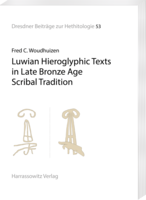|
|
more titles of the subject:
Download:
Please note: With adding digital Products to your cart
the payment will be handled via PayPal. The download will be provided after the payment is confirmed. Of all texts in Luwian hieroglyphic, the ones from the Bronze Age, or, to be more specific, in Late Bronze Age scribal tradition (which includes the earliest phase of the Early Iron Age), have received limited attention. If books on the topic may serve as an indication, there is only Massimo Poetto’s edition of the Yalburt text of 1993 and David Hawkins’ edition of the Südburg text of 1995.
In this volume, Fred C. Woudhuizen discusses all Luwian hieroglyphic texts in Late Bronze Age scribal tradition of minimally one phrase length, entailing 31 texts in sum and a total of 233 phrases. Among this set of texts features the recently rediscovered Beyköy 2, the authenticity of which has been called into question. To meet these doubts arguments pro and con authenticity of Beyköy 2 are discussed at length. The linguistic results are summarized in an overview of the system of (pro)nominal declension and verbal conjugation, which, contrary to commonly held views, turns out to present us with a reasonably complete set of paradigms. An index of words and elements further provides the reader with an indispensable working tool. The system of transliteration in this work deviates from the current standard as set by Procida 1998. Most important is the fact that the so-called “new reading” of the sign pairs *376-377 and *209-210 has been shown by Woudhuizen to be flawed and therefore should be replaced by the “adjusted old reading”. To facilitate the reader in this respect, a concordance is presented in which the transliteration of the individual signs as used in this book is correlated to the standard currently in use. |
|||||||||||||||||||||||||||||||||||||||






